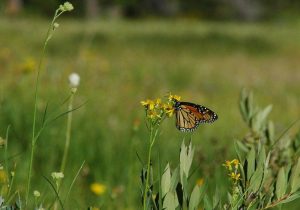The Stunning Monarch Butterfly and Milkweed
I’ve lived in my home about two years and I’ve marveled at the monarch butterflies that flourish here. Monarch butterflies are a miraculous species and the only butterfly that performs a two-way migration. Their range spans all of North America, touching three countries and the entire continental United States. Until recently, it’s seemed monarchs would always be part of our gardens. However, in just two decades monarch populations have declined almost 90%. The decline of the Monarch population is believed to be due to the eradication of milkweed due to agricultural growth, development of rural lands and herbicides. We all need to actively participate in helping these beautiful creatures avoid extinction.
Short of spelling out the rather complicated generational cycles of the monarch, the important thing to know about monarchs is what they need to survive. Female monarchs will only lay their eggs on milkweed leaves, and the monarch larvae will eat only milkweed leaves.
Milkweeds are named for their milky sap. The plant tissues contain cardenolides, a type of steroid. When the Monarch caterpillars eat the plants, the plant protects them by making them distasteful to predators. Mother Nature sure has some cool ways of doing things, doesn’t she? However, even this trick for survival can’t overcome the human interaction that could put an end to the monarch.
Over the last two years I’ve been happy to see the monarch in my yard feeding on my vast array of nectar plants. Assuming a neighbor had the much needed milkweed, I settled for being lucky enough to get visits from the beautiful adult. Recently, I decided it’s about time I become actively involved in helping this marvel of nature. I planted two milkweed plants for starters and plan to invest in more.
The two species of milkweed I have in my garden now are Asclepias speciosa (showy milkweed) and Asclepias fascicularis (narrow-leafed milkweed). Both are deciduous, drought tolerant and California natives. Be careful to stay clear of the tropical milkweed species, A. curassavica, also known as ‘Bright Wings’. There has been concern that because this non-native species is not deciduous and providing year-round nectar in mild winter areas, it might be encouraging the monarch to lay eggs outside their regular breeding season. It is also thought the butterflies may linger longer than they normally would and risk freezing. Plus there is an association with higher parasitism rates in monarchs that feed on this variety of milkweed.
The adult stage, the stage we see as the monarch butterfly, depends on diverse nectar sources for food during all stages of the year, from spring and summer breeding to fall migration and overwintering. A combination of early, middle and late blooming species will fuel butterfly breeding and migration. Besides the milkweed, the monarch feeds on sulfur flower, goldenrod, verbena, common sunflower, hyssop, California buckeye, coyote bush, and desert willow. These are just a few of a long list of the nectar plants that do well in our region. Most of these I have in
my garden. All are easy to grow, many are drought tolerant, and all need full sun. I especially love the verbena ‘Homestead Purple’. It flowers continuously from spring to fall, and it is highly desired by the Monarchs.
I think we need to consider this as another sign that Mother Nature knows best. One of the most significant actions you can take to prevent the decline of this magnificent creature is to invest in some milkweed; even just one will provide food for many butterflies. Encourage your neighbors as well. Also, if you can, limit or eliminate the use of insecticides and herbicides in your yard. When spring comes and you see your first monarch happily fluttering in the garden you can be proud that you contributed to its survival.
Wendy Weidenman is a University of California Cooperative Extension Master Gardener of Tuolumne County.

